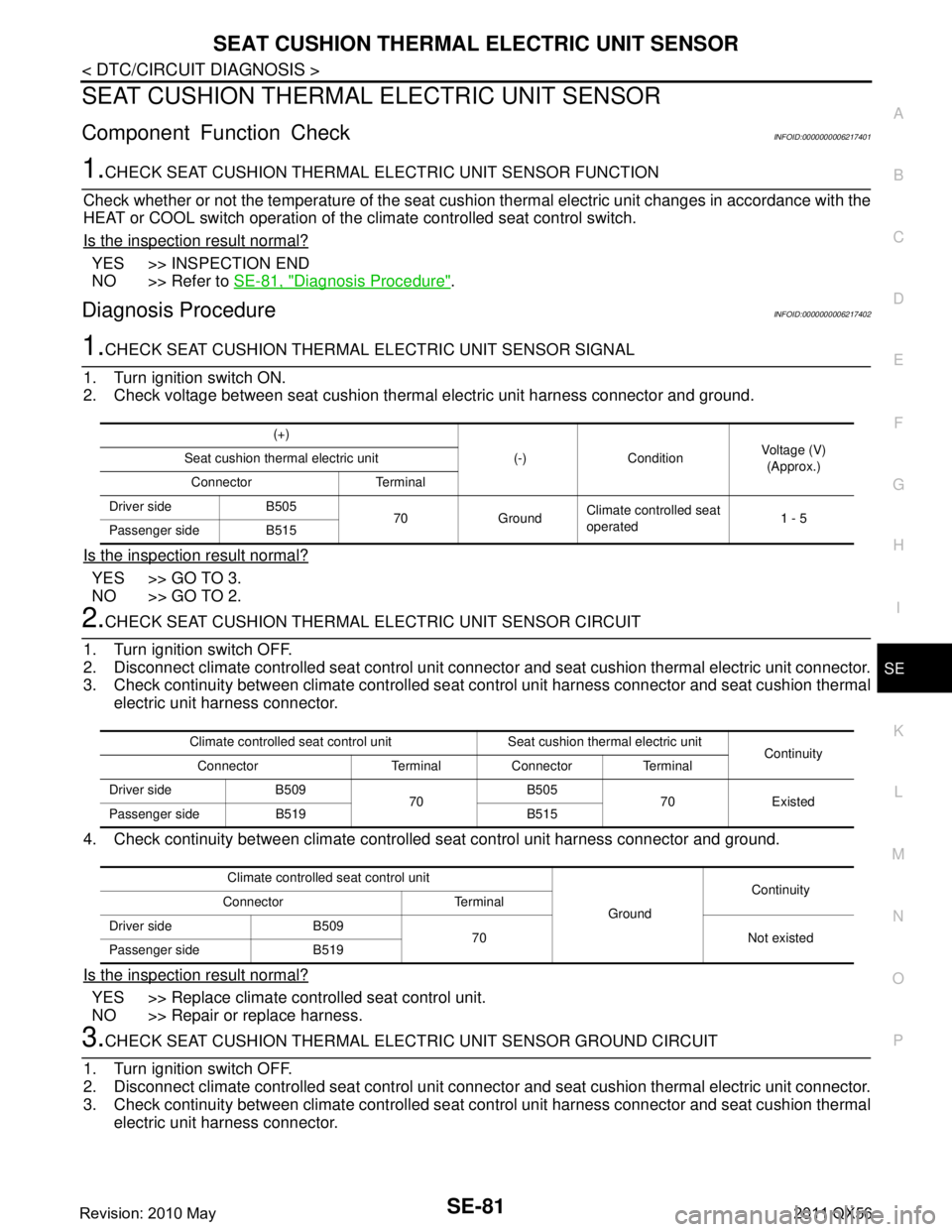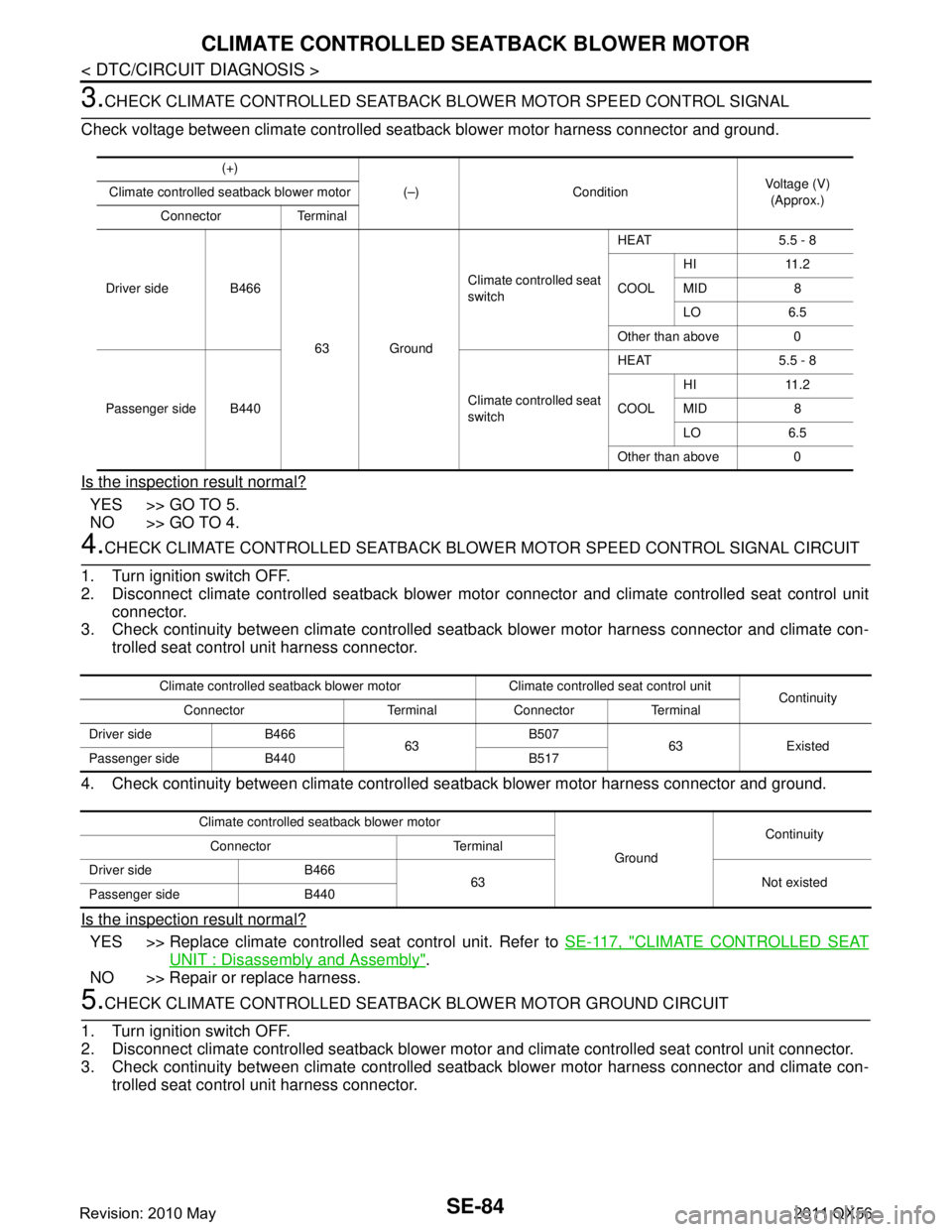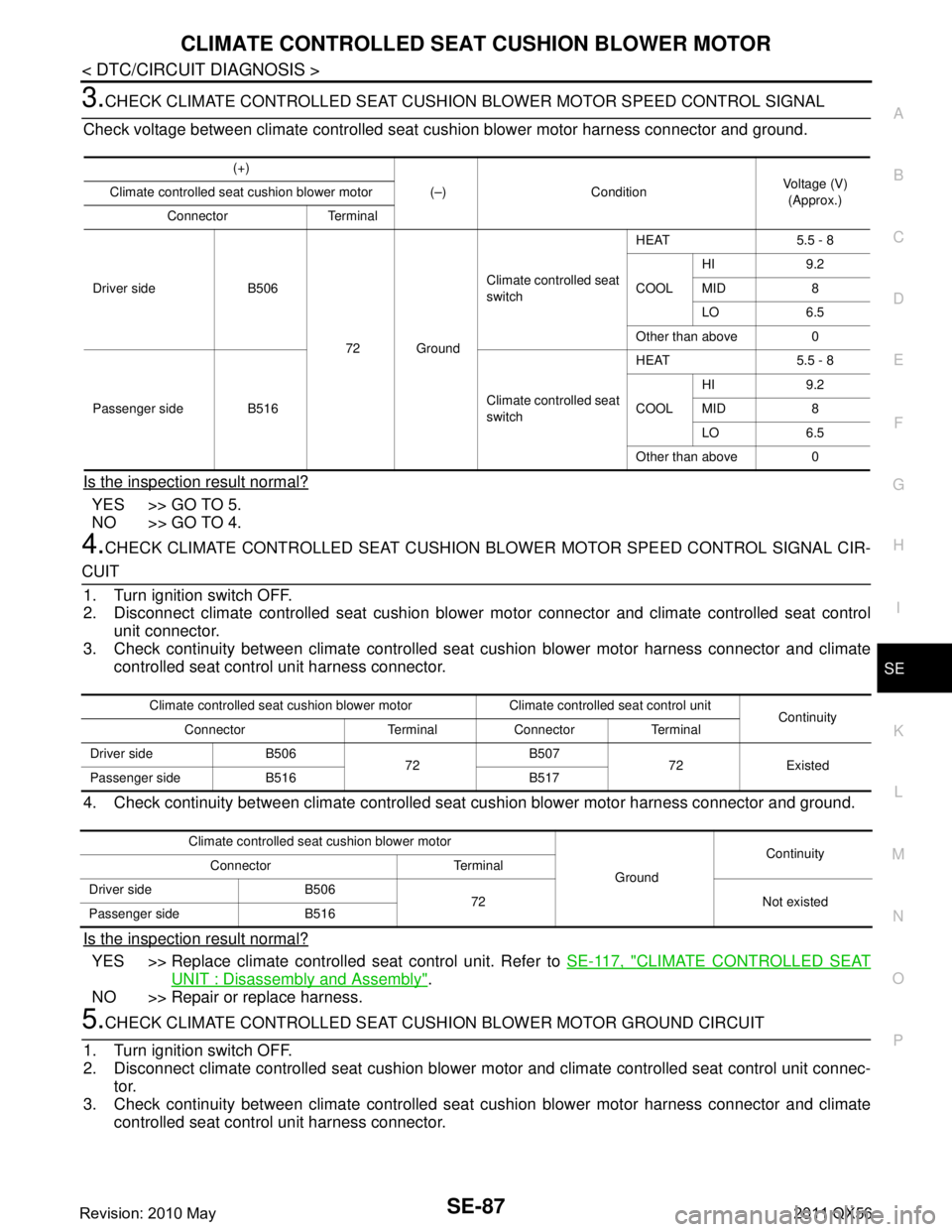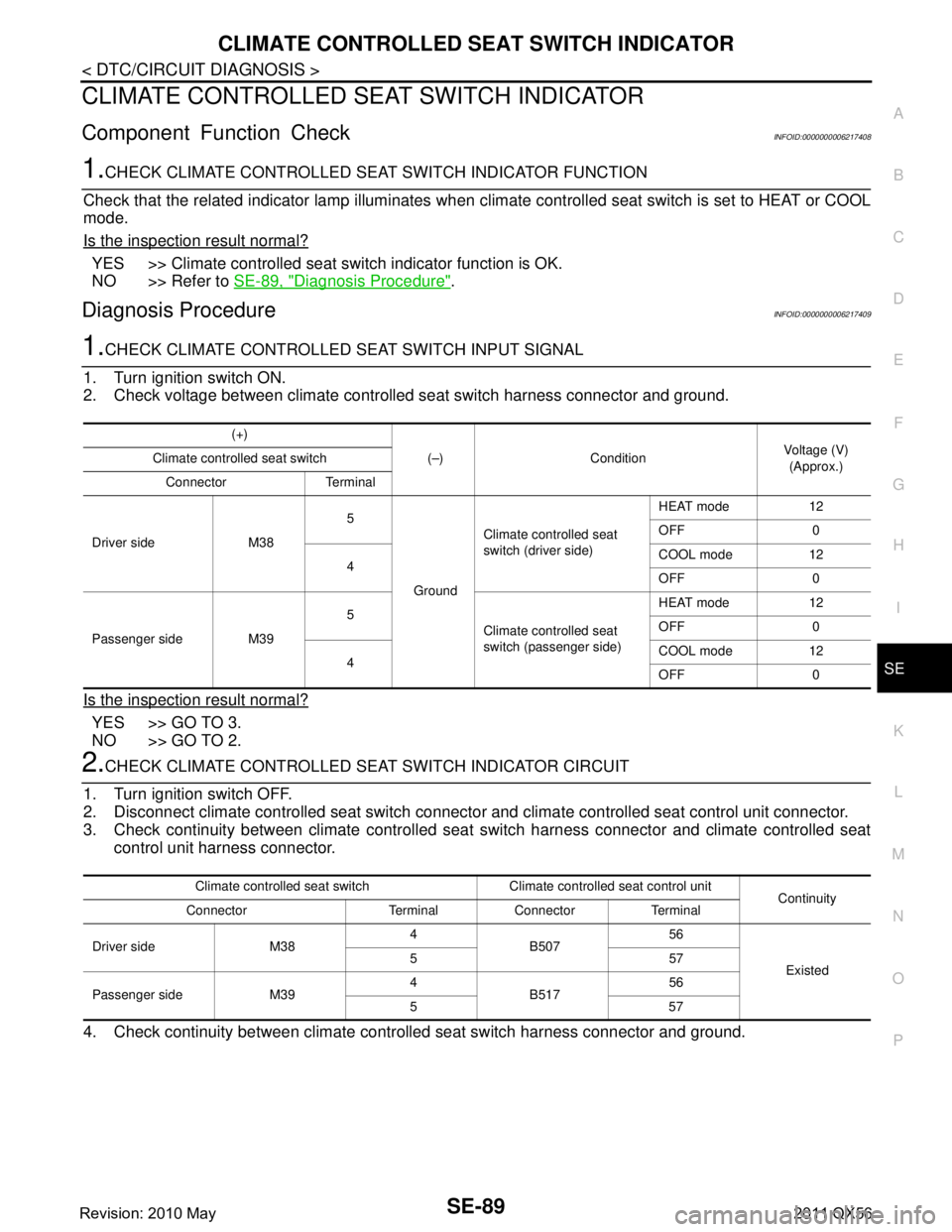2011 INFINITI QX56 turn signal
[x] Cancel search: turn signalPage 4540 of 5598

SEAT CUSHION THERMAL ELECTRIC UNIT SENSORSE-81
< DTC/CIRCUIT DIAGNOSIS >
C
DE
F
G H
I
K L
M A
B
SE
N
O P
SEAT CUSHION THERMAL ELECTRIC UNIT SENSOR
Component Function CheckINFOID:0000000006217401
1.CHECK SEAT CUSHION THERMAL ELECTRIC UNIT SENSOR FUNCTION
Check whether or not the temperature of the seat cush ion thermal electric unit changes in accordance with the
HEAT or COOL switch operation of the climate controlled seat control switch.
Is the inspection result normal?
YES >> INSPECTION END
NO >> Refer to SE-81, "
Diagnosis Procedure".
Diagnosis ProcedureINFOID:0000000006217402
1.CHECK SEAT CUSHION THERMAL ELECTRIC UNIT SENSOR SIGNAL
1. Turn ignition switch ON.
2. Check voltage between seat cushion ther mal electric unit harness connector and ground.
Is the inspection result normal?
YES >> GO TO 3.
NO >> GO TO 2.
2.CHECK SEAT CUSHION THERMAL ELECTRIC UNIT SENSOR CIRCUIT
1. Turn ignition switch OFF.
2. Disconnect climate controlled seat control unit connec tor and seat cushion thermal electric unit connector.
3. Check continuity between climate controlled seat control unit harness connector and seat cushion thermal
electric unit harness connector.
4. Check continuity between climate controll ed seat control unit harness connector and ground.
Is the inspection result normal?
YES >> Replace climate controlled seat control unit.
NO >> Repair or replace harness.
3.CHECK SEAT CUSHION THERMAL ELEC TRIC UNIT SENSOR GROUND CIRCUIT
1. Turn ignition switch OFF.
2. Disconnect climate controlled seat control unit connec tor and seat cushion thermal electric unit connector.
3. Check continuity between climate controlled seat control unit harness connector and seat cushion thermal
electric unit harness connector.
(+)
(-) Condition Voltage (V)
(Approx.)
Seat cushion thermal electric unit
Connector Terminal
Driver side B505 70 GroundClimate controlled seat
operated
1 - 5
Passenger side B515
Climate controlled seat control unit Seat cushion thermal electric unit Continuity
Connector Terminal Connector Terminal
Driver side B509 70B505
70 Existed
Passenger side B519 B515
Climate controlled seat control unit GroundContinuity
Connector Terminal
Driver side B509 70 Not existed
Passenger side B519
Revision: 2010 May2011 QX56
Page 4543 of 5598

SE-84
< DTC/CIRCUIT DIAGNOSIS >
CLIMATE CONTROLLED SEATBACK BLOWER MOTOR
3.CHECK CLIMATE CONTROLLED SEATBACK BLOWER MOTOR SPEED CONTROL SIGNAL
Check voltage between climate controlled seat back blower motor harness connector and ground.
Is the inspection result normal?
YES >> GO TO 5.
NO >> GO TO 4.
4.CHECK CLIMATE CONTROLLED SEATBACK BLOWER MOTOR SPEED CONTROL SIGNAL CIRCUIT
1. Turn ignition switch OFF.
2. Disconnect climate controlled seatback blower moto r connector and climate controlled seat control unit
connector.
3. Check continuity between climate controlled seat back blower motor harness connector and climate con-
trolled seat control unit harness connector.
4. Check continuity between climate controlled seatback blower motor harness connector and ground.
Is the inspection result normal?
YES >> Replace climate controlled seat control unit. Refer to SE-117, "CLIMATE CONTROLLED SEAT
UNIT : Disassembly and Assembly".
NO >> Repair or replace harness.
5.CHECK CLIMATE CONTROLLED SEATBACK BLOWER MOTOR GROUND CIRCUIT
1. Turn ignition switch OFF.
2. Disconnect climate controlled seatback blower moto r and climate controlled seat control unit connector.
3. Check continuity between climate controlled seat back blower motor harness connector and climate con-
trolled seat control unit harness connector.
(+)
(–) Condition Voltage (V)
(Approx.)
Climate controlled seatback blower motor
Connector Terminal
Driver side B466 63 GroundClimate controlled seat
switch
HEAT 5.5 - 8
COOL
HI 11.2
MID 8
LO 6.5
Other than above 0
Passenger side B440 Climate controlled seat
switchHEAT 5.5 - 8
COOL
HI 11.2
MID 8
LO 6.5
Other than above 0
Climate controlled seatback blower motor Climate controlled seat control unit Continuity
Connector Terminal Connector Terminal
Driver side B466 63B507
63 Existed
Passenger side B440 B517
Climate controlled seatback blower motor
GroundContinuity
Connector Terminal
Driver side B466 63 Not existed
Passenger side B440
Revision: 2010 May2011 QX56
Page 4546 of 5598

CLIMATE CONTROLLED SEAT CUSHION BLOWER MOTORSE-87
< DTC/CIRCUIT DIAGNOSIS >
C
DE
F
G H
I
K L
M A
B
SE
N
O P
3.CHECK CLIMATE CONTROLLED SEAT CUSHION BLOWER MOTOR SPEED CONTROL SIGNAL
Check voltage between climate controlled seat cushion blower motor harness connector and ground.
Is the inspection result normal?
YES >> GO TO 5.
NO >> GO TO 4.
4.CHECK CLIMATE CONTROLLED SEAT CUSHION BL OWER MOTOR SPEED CONTROL SIGNAL CIR-
CUIT
1. Turn ignition switch OFF.
2. Disconnect climate controlled seat cushion blower motor connector and climate controlled seat control
unit connector.
3. Check continuity between climate controlled seat cushion blower motor harness connector and climate
controlled seat control unit harness connector.
4. Check continuity between climate controlled s eat cushion blower motor harness connector and ground.
Is the inspection result normal?
YES >> Replace climate controlled seat control unit. Refer to SE-117, "CLIMATE CONTROLLED SEAT
UNIT : Disassembly and Assembly".
NO >> Repair or replace harness.
5.CHECK CLIMATE CONTROLLED SEAT CUSHI ON BLOWER MOTOR GROUND CIRCUIT
1. Turn ignition switch OFF.
2. Disconnect climate controlled seat cushion blower motor and climate controlled seat control unit connec-
tor.
3. Check continuity between climate controlled seat cushion blower motor harness connector and climate
controlled seat control unit harness connector.
(+)
(–) Condition Voltage (V)
(Approx.)
Climate controlled seat cushion blower motor
Connector Terminal
Driver side B506 72 GroundClimate controlled seat
switch
HEAT 5.5 - 8
COOL
HI 9.2
MID 8
LO 6.5
Other than above 0
Passenger side B516 Climate controlled seat
switchHEAT 5.5 - 8
COOL
HI 9.2
MID 8
LO 6.5
Other than above 0
Climate controlled seat cushion blower motor Climate controlled seat control unit Continuity
Connector Terminal Connector Terminal
Driver side B506 72B507
72 Existed
Passenger side B516 B517
Climate controlled seat cushion blower motor
GroundContinuity
Connector Terminal
Driver side B506 72 Not existed
Passenger side B516
Revision: 2010 May2011 QX56
Page 4548 of 5598

CLIMATE CONTROLLED SEAT SWITCH INDICATORSE-89
< DTC/CIRCUIT DIAGNOSIS >
C
DE
F
G H
I
K L
M A
B
SE
N
O P
CLIMATE CONTROLLED SEAT SWITCH INDICATOR
Component Function CheckINFOID:0000000006217408
1.CHECK CLIMATE CONTROLLED SEA T SWITCH INDICATOR FUNCTION
Check that the related indicator lamp illuminates when c limate controlled seat switch is set to HEAT or COOL
mode.
Is the inspection result normal?
YES >> Climate controlled seat switch indicator function is OK.
NO >> Refer to SE-89, "
Diagnosis Procedure".
Diagnosis ProcedureINFOID:0000000006217409
1.CHECK CLIMATE CONTROLLED SEAT SWITCH INPUT SIGNAL
1. Turn ignition switch ON.
2. Check voltage between climate controll ed seat switch harness connector and ground.
Is the inspection result normal?
YES >> GO TO 3.
NO >> GO TO 2.
2.CHECK CLIMATE CONTROLLED SEA T SWITCH INDICATOR CIRCUIT
1. Turn ignition switch OFF.
2. Disconnect climate controlled seat switch connecto r and climate controlled seat control unit connector.
3. Check continuity between climate controlled seat switch harness connector and climate controlled seat
control unit harness connector.
4. Check continuity between climate contro lled seat switch harness connector and ground.
(+)
(–) Condition Voltage (V)
(Approx.)
Climate controlled seat switch
Connector Terminal
Driver side M38 5
Ground Climate controlled seat
switch (driver side)
HEAT mode 12
OFF 0
4 COOL mode 12
OFF 0
Passenger side M39 5
Climate controlled seat
switch (passenger side) HEAT mode 12
OFF 0
4 COOL mode 12
OFF 0
Climate controlled seat switch Climate controlled seat control unit
Continuity
Connector Terminal Connector Terminal
Driver side M38 4
B507 56
Existed
557
Passenger side M39 4
B517 56
557
Revision: 2010 May2011 QX56
Page 4616 of 5598
![INFINITI QX56 2011 Factory Service Manual
COMPONENT PARTSSEC-9
< SYSTEM DESCRIPTION > [WITH INTELLIGENT KEY SYSTEM]
C
D
E
F
G H
I
J
L
M A
B
SEC
N
O P
Then, when the power supply position is turned ON, BCM performs ID verification between BC INFINITI QX56 2011 Factory Service Manual
COMPONENT PARTSSEC-9
< SYSTEM DESCRIPTION > [WITH INTELLIGENT KEY SYSTEM]
C
D
E
F
G H
I
J
L
M A
B
SEC
N
O P
Then, when the power supply position is turned ON, BCM performs ID verification between BC](/manual-img/42/57033/w960_57033-4615.png)
COMPONENT PARTSSEC-9
< SYSTEM DESCRIPTION > [WITH INTELLIGENT KEY SYSTEM]
C
D
E
F
G H
I
J
L
M A
B
SEC
N
O P
Then, when the power supply position is turned ON, BCM performs ID verification between BCM and ECM. If
the ID verification result is OK, ECM can start engine.
ECMINFOID:0000000006226155
ECM controls the engine.
When power supply position is turned ON, BCM starts communication with ECM and performs the ID verifica-
tion between BCM and ECM.
If the verification result is OK, the engine can start. If the verification result is NG, the engine can not start.
IPDM E/RINFOID:0000000006226156
IPDM E/R has steering lock relay, starter relay and starte r control relay inside. Steering lock relay is used for
the steering lock/unlock function. Starter relay and star ter control relay are used for the engine starting func-
tion. IPDM E/R controls these relays while communicating with BCM.
NATS Antenna Amp.INFOID:0000000006226157
The ID verification is performed between BCM and transponder in Intelligent Key via NATS antenna amp.
when Intelligent Key backside is contacted to push-button i gnition switch in case that Intelligent Key battery is
discharged. If the ID verification result is OK, the release of steering lock and the operation of starting engine
is available.
TCMINFOID:0000000006226158
TCM transmits the shift position signal (P/N position) to BCM and IPDM E/R. And further, TCM transmits the
shift position signal (P/N position) to BCM via CAN communication.
BCM confirms the A/T shift selector position with the following 5 signals.
P position signal from A/T shift selector (detention switch)
P/N position signal from TCM
P position signal from IPDM E/R (CAN)
P/N position signal from IPDM E/R (CAN)
P/N position signal from TCM (CAN)
IPDM E/R confirms the A/T shift sele ctor position with the following 3 signals.
P position signal from A/T shift selector (detention switch)
P/N position signal from TCM
P/N position signal from BCM (CAN)
Combination MeterINFOID:0000000006226159
Combination meter transmits the vehicle speed signal to BCM via CAN communication.
BCM also receives the vehicle speed signal from ABS ac tuator and electric unit (control unit) via CAN commu-
nication. BCM compares both signals to detect the vehicle speed.
Door SwitchINFOID:0000000006226160
Door switch detects door open/close condition and then transmits ON/OFF signal to BCM.
Hood SwitchINFOID:0000000006226161
Hood switch detects that hood is open, and then transmits the signal to IPDM E/R. IPDM E/R transmits hood
switch signal to BCM via CAN communication.
Inside Key AntennaINFOID:0000000006226162
Inside key antenna detects whether Intelligent Key is inside the vehicle, and transmits the signal to BCM.
Three inside key antennas are installed in t he instrument center, console and luggage room.
Intelligent KeyINFOID:0000000006226163
Each Intelligent key has an individual electronic ID , and transmits the ID signal by request from BCM.
Carrying the Intelligent Key whose ID is registered in BCM, the driver can performs door lock/unlock operation
and push-button ignition switch operation.
Revision: 2010 May2011 QX56
Page 4617 of 5598
![INFINITI QX56 2011 Factory Service Manual
SEC-10
< SYSTEM DESCRIPTION >[WITH INTELLIGENT KEY SYSTEM]
COMPONENT PARTS
Push-button Ignition Switch
INFOID:0000000006226165
Push-button ignition switch detects that push-button is pressed, and th INFINITI QX56 2011 Factory Service Manual
SEC-10
< SYSTEM DESCRIPTION >[WITH INTELLIGENT KEY SYSTEM]
COMPONENT PARTS
Push-button Ignition Switch
INFOID:0000000006226165
Push-button ignition switch detects that push-button is pressed, and th](/manual-img/42/57033/w960_57033-4616.png)
SEC-10
< SYSTEM DESCRIPTION >[WITH INTELLIGENT KEY SYSTEM]
COMPONENT PARTS
Push-button Ignition Switch
INFOID:0000000006226165
Push-button ignition switch detects that push-button is pressed, and then transmits the signal to BCM. BCM
changes the power supply position with the operation of push-button ignition switch. BCM maintains the power
supply position status while push-button is not operated.
Remote Keyless Entry ReceiverINFOID:0000000006226166
Remote keyless entry receiver receives each button oper ation signal and electronic key ID signal from Intelli-
gent Key, and then transmits the signal to BCM.
Security Indicator LampINFOID:0000000006226167
Security indicator lamp is located on combination meter.
Security indicator lamp blinks when power supply position is any position other than ON to warn that INFINITI
VEHICLE IMMOBILIZER SYSTEM-N ATS [IVIS (NATS)] is on board.
Starter Control RelayINFOID:0000000006226170
Engine starting system functions by controlling both starter relay and starter control relay.
Both relays are integrated in IPDM E/R. Starter relay is controlled by BCM, and starter control relay is con-
trolled by IPDM E/R on request from BCM.
IPDM E/R transmits starter relay and starter control relay status signal to BCM via CAN communication.
Starter RelayINFOID:0000000006226171
Engine starting system functions by controlling both starter relay and starter control relay.
Both relays are integrated in IPDM E/R. Starter relay is controlled by BCM, and starter control relay is con-
trolled by IPDM E/R on request from BCM.
IPDM E/R transmits starter relay and starter control relay status signal to BCM via CAN communication.
Steering Lock RelayINFOID:0000000006226172
Steering lock relay is integrated in IPDM E/R, and supplies power source to steering lock unit.
When IPDM E/R receives the steering lock relay ON request signal from BCM, IPDM E/R turns ON steering
lock relay and then transmits the steering lock relay condition signal to BCM.
Steering Lock UnitINFOID:0000000006226173
Steering lock unit performs steering lock/unlock operation on request from BCM, and power source is supplied
from steering lock relay integrated in IPDM E/R.
When push-button ignition switch is pressed while the In telligent Key is inside the vehicle, BCM performs the
ID verification with steering lock unit. Steering lock unit releases the steering lock based on the result of the ID
verification.
Steering lock unit has 2 switches (steering lock status switch and steering unlock status switch) inside. BCM
judges the steering lock/unlock condition by comparing these switch signals and steering lock unit status sig-
nal transmitted from IPDM E/R via CAN communication.
Stop Lamp SwitchINFOID:0000000006226174
Stop lamp switch detects that brake pedal is depressed, and then transmits the signal to BCM.
Transmission Range SwitchINFOID:0000000006226175
Transmission range switch is integrated in A/T asse mbly, and detects the A/T shift selector position.
TCM receives the transmission range switch signal and then transmits the P/N position signal to BCM and
IPDM E/R.
BCM confirms the A/T shift selector position with the following 5 signals.
P position signal from A/T shift selector (detention switch)
P/N position signal from TCM
P position signal from IPDM E/R (CAN)
P/N position signal from IPDM E/R (CAN)
P/N position signal from TCM (CAN)
IPDM E/R confirms the A/T shift select or position with the following 3 signals.
Revision: 2010 May2011 QX56
Page 4620 of 5598
![INFINITI QX56 2011 Factory Service Manual
SYSTEMSEC-13
< SYSTEM DESCRIPTION > [WITH INTELLIGENT KEY SYSTEM]
C
D
E
F
G H
I
J
L
M A
B
SEC
N
O P
Up to 4 Intelligent Keys can be registered (Includi ng the standard Intelligent Key) upon request INFINITI QX56 2011 Factory Service Manual
SYSTEMSEC-13
< SYSTEM DESCRIPTION > [WITH INTELLIGENT KEY SYSTEM]
C
D
E
F
G H
I
J
L
M A
B
SEC
N
O P
Up to 4 Intelligent Keys can be registered (Includi ng the standard Intelligent Key) upon request](/manual-img/42/57033/w960_57033-4619.png)
SYSTEMSEC-13
< SYSTEM DESCRIPTION > [WITH INTELLIGENT KEY SYSTEM]
C
D
E
F
G H
I
J
L
M A
B
SEC
N
O P
Up to 4 Intelligent Keys can be registered (Includi ng the standard Intelligent Key) upon request from the cus-
tomer.
NOTE:
Refer to DLK-18, "
INTELLIGENT KEY SYSTEM : System Description" for any functions other than engine
start function of Intelligent Key system.
PRECAUTIONS FOR INTELLIGENT KEY SYSTEM
The transponder [the chip for IVIS (NATS) ID verification] is integrated into the Intelligent Key. (For the
conventional models, it is integrated into the mech anical key.) Therefore, ID verification cannot be per-
formed by mechanical key only.
In that case, the IVIS (NATS) ID verification can be performed when Intelligent Key backside is con-
tacted to push-button ignition switch. If verification result is OK, engine can be started.
OPERATION WHEN INTELLIGENT KEY IS CARRIED
1. When the push-button ignition switch is pressed, the BCM activates the inside key antenna and transmits
the request signal to the Intelligent Key.
2. The Intelligent Key receives the request signal and transmits the Intelligent Key ID signal to the BCM.
3. BCM receives the Intelligent Key ID signal via remote keyless entry receiver and verifies it with the regis-
tered ID.
4. BCM transmits the unlock signal to steering lock unit and IPDM E/R if the verification results are OK.
5. IPDM E/R turns the steering lock relay ON and supplies power supply to the steering lock unit.
6. The steering lock releases.
7. BCM transmits the power supply stop signal to IPDM E/R when detecting that the steering lock is in the
unlock condition.
8. IPDM E/R turns the steering lock relay OFF and stops power supply to the steering lock unit.
9. BCM turns ACC relay ON and transmits the ignition power supply ON signal to IPDM E/R.
10. IPDM E/R turns the ignition relay ON and starts the ignition power supply.
11. BCM detects that the selector lever position and brake pedal operating condition.
12. BCM transmits the starter request signal to IPDM E/R and turns the starter relay in IPDM E/R ON if BCM
judges that the engine start condition* is satisfied.
13. IPDM E/R turns the starter control relay ON when receiving the starter request signal.
14. Power supply is supplied through the starter relay and the starter control relay to operate the starter motor. CAUTION:
If a malfunction is detected in the Intelligent Key system, the “KEY” warning lamp in the combina-
tion meter illuminates. At that time, the engine cannot be started.
15. When BCM receives feedback signal from ECM indicati ng that the engine is started, the BCM transmits a
stop signal to IPDM E/R and stops cranking by turning OFF the starter motor relay. (If engine start is
unsuccessful, cranking stops automatically within 5 seconds.)
CAUTION:
When the Intelligent Key is carried outside of th e vehicle (inside key antenna detection area) while
the power supply is in the ACC or ON position, even if the engine start condition* is satisfied, the
engine cannot be started.
*: For the engine start condition, refer to “POWER SUPPLY POSITION CHANGE TABLE BY PUSH-BUTTON
IGNITION SWITCH OPERATION”.
OPERATION RANGE
Engine can be started when Intelligent Key is inside the vehicle. However, sometimes engine may not start
when Intelligent Key is on instrument panel or in glove box.
ENGINE START OPERATION WHEN INTELLIGENT KEY IS CONTACTED TO PUSH-BUTTON IG-
NITION SWITCH
When Intelligent Key battery is discharged, the IVIS (NATS) ID verification between transponder in Intelligent
Key and BCM is performed when Intelligent Key backside is contacted to push-button ignition switch. If the
verification result is OK, engine can be started.
STEERING LOCK OPERATION
Steering is locked by steering lock unit when any of the following conditions are met.
Revision: 2010 May2011 QX56
Page 4623 of 5598
![INFINITI QX56 2011 Factory Service Manual
SEC-16
< SYSTEM DESCRIPTION >[WITH INTELLIGENT KEY SYSTEM]
SYSTEM
PRECAUTIONS FOR KEY REGISTRATION
The ID registration is a procedure that erases the cu
rrent IVIS (NATS) ID once, and then reregist INFINITI QX56 2011 Factory Service Manual
SEC-16
< SYSTEM DESCRIPTION >[WITH INTELLIGENT KEY SYSTEM]
SYSTEM
PRECAUTIONS FOR KEY REGISTRATION
The ID registration is a procedure that erases the cu
rrent IVIS (NATS) ID once, and then reregist](/manual-img/42/57033/w960_57033-4622.png)
SEC-16
< SYSTEM DESCRIPTION >[WITH INTELLIGENT KEY SYSTEM]
SYSTEM
PRECAUTIONS FOR KEY REGISTRATION
The ID registration is a procedure that erases the cu
rrent IVIS (NATS) ID once, and then reregisters a new
ID. Therefore before starting the registration operation, collect all registered Intelligent Keys from the cus-
tomer.
When registering the Intelligent Key, perform only one procedure to simultaneously register both ID [IVIS
(NATS) ID and Intelligent Key ID].
SECURITY INDICATOR LAMP
Warns that the vehicle is equipped with IVIS (NATS).
Security indicator lamp always blinks when the pow er supply position is any position other than ON.
NOTE:
Because security indicator lamp is highly efficient, the battery is barely affected.
ENGINE START OPERATION WHEN INTELLIGENT KEY IS CONTACTED TO PUSH-BUTTON IG-
NITION SWITCH
1. When brake pedal is depressed while selector leve r is in the P position, BCM activates NATS antenna
amp. that is located behind push-button ignition switch.
2. When Intelligent Key (transponder built-in) backsi de is contacted to push-button ignition switch, BCM
starts IVIS (NATS) ID verification between BCM and Intelligent Key (transponder built-in) via NATS
antenna amp.
3. When the IVIS (NATS) ID verification result is OK, buzzer in combination meter sounds and BCM trans-
mits the result to ECM.
4. When push-button ignition switch is pressed, BCM transmits steering unlock signal to steering lock unit
and IPDM E/R.
5. IPDM E/R turns steering lock relay ON and supplies power supply to the steering lock unit.
6. The steering lock is released.
7. BCM transmits the power supply stop signal to IPDM E/R when detecting that the steering lock is in the
unlock position.
8. IPDM E/R turns steering lock relay OFF and stops power supply to the steering lock unit.
9. BCM turns ACC relay ON and transmits ignition power supply ON signal to IPDM E/R.
10. IPDM E/R turns the ignition relay ON and starts the ignition power supply.
11. BCM detects that the selector lever position is P or N.
12. BCM transmits starter request signal to IPDM E/R and turns the starter relay in IPDM E/R ON if BCM judges that the engine start condition* is satisfied.
13. IPDM E/R turns the starter control relay ON when receiving the starter request signal.
14. Power supply is supplied through the starter relay and the starter control relay to operate the starter motor.
15. When BCM receives feedback signal from ECM indica ting that the engine is started, BCM transmits a
stop signal to IPDM E/R and stops cranking by turning off the starter motor relay. (If engine start is unsuc-
cessful, cranking stops automatically within 5 seconds.)
*: For the engine start condition, refer to “POWER SUPPLY POSITION CHANGE TABLE BY PUSH-BUTTON
IGNITION SWITCH OPERATION” below.
POWER SUPPLY POSITION CHANGE TABLE BY PUSH-BUTTON IGNITION SWITCH OPERA-
TION
The power supply position changing operation can be performed with the following operations.
NOTE:
When an Intelligent Key is within the detection area of inside key antenna and when Intelligent Key backside
is contacted to push-button ignition switch, it is equivalent to the operations below.
When starting the engine, the BCM monitors under the engine start conditions,
- Brake pedal operating condition
- Selector lever position
- Vehicle speed
Vehicle speed: less than 4 km/h (2.5 MPH)
Revision: 2010 May2011 QX56